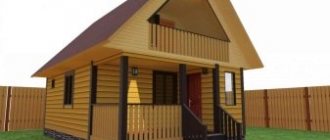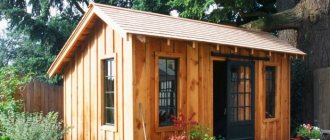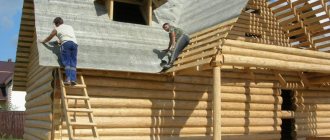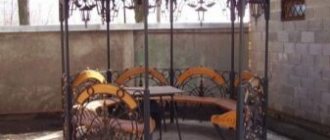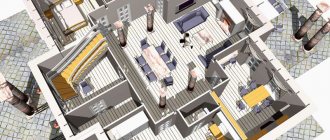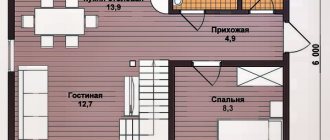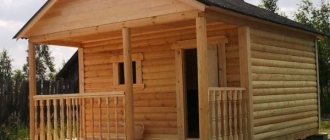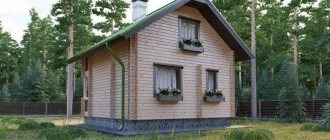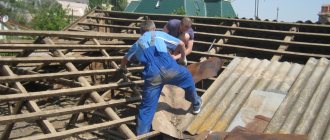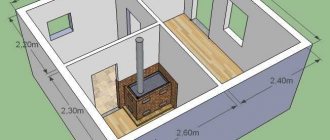There are probably few sorrows in the world that cannot be cured with a good old bath. Especially if this bathhouse is private property and is logically integrated into a single living space. In this case, the highest comfort is guaranteed. But only if you took care of it ahead of time. And to do this, you need to take into account all the nuances at the stage of creating the project and fit the bathhouse into the project in such a way that after, already enjoying this sweet hundred-degree torture, you can praise yourself in your thoughts for a successfully implemented idea. Of course, not every person can boast of engineering vision and consider all the advantages of building a bathhouse with an attic at the planning stage. In this case, our material will definitely help you.
Advantages
- a good option for expanding useful space when there is a shortage of space;
- the ability to place a recreation area on an additional site, which harmoniously fits into the use of the bathhouse;
- optimization of the site by equipping auxiliary premises - for example, a storage room;
- use as a guest room or a mini-bedroom option during festive events;
- cost savings compared to a two-story structure.
In short, bathhouses with an attic allow you to solve several problems at once with obvious benefit to yourself. And even if chasing two birds with one stone, there is always a risk of missing both, people sensibly assess all the possibilities and successfully implement such an idea on their plots. As proof - a huge number of projects for bathhouses with an attic for a wide variety of sizes. Let's start with the most popular ones.
House layout 6 by 6
When designing a compact house, its purpose is taken into account. This could be a country house for summer holidays or a house for year-round residence of a small family. In the first case, the layout allocates more space for the personal premises of the owners, and the daytime area is planned with a minimum area.
If a house with an area of about 36 sq. meters will be used as a permanent home; when designing the daytime area, more attention is paid. In addition, in a year-round house it is necessary to provide space for technical premises.
Cottage
Single-story 6 by 6 buildings are ideal for older people, as well as for young families who do not yet have the funds to build a large private house. The advantages of such houses are not only that they are inexpensive to build, but also that they are very economical to operate. They do not require large heating and repair costs, and besides, such a house is not at all difficult to care for.
With this solution, the inside of the cottage seems more spacious and bright. But the bedroom is still often planned to be isolated. The bathroom must be isolated. It is advisable to have a closed buffer zone in the form of a hallway or a small vestibule at the front door.
Two-storey house
Two-story country houses of any size can be attic or with a full second floor. The regular and attic upper level have several important differences:
- a regular floor has more usable space;
- it is cheaper to build an attic;
- the attic roof must be equipped by highly qualified specialists;
- the attic floor adds a minimum of weight to the overall structure of the building.
It is worth noting that it is better to build small houses with attics. In this case, they turn out to be more proportional, which has a beneficial effect on both the appearance of the building and its structural characteristics.
In a two-story house, sleeping quarters are usually located on the second floor. If the layout of a 6 by 6 one-story house involves placing one bedroom next to the living room, then in a two-level cottage the bedrooms form a separate quiet area on the second floor, intended only for the owners.
It should be noted that in a two-story building, part of the internal area will be allocated for the interfloor staircase and landings. That is, the territory of the lower floor of a small house turns out to be much smaller.
Projects 6x6 m
- excellent saving of usable space and quite a large space in the equipped attic;
- on the ground floor you can place a separate steam room and sink;
- depending on the number of people who regularly use the bathhouse, you can make the rooms larger or smaller;
- possibility of arranging a small terrace.
Today, this format should be recognized as one of the most common. Popular designs for 6x6 bathhouses with an attic include not only the actual functional rooms, but also relaxation rooms and terraces, which in different cases are no less important than the design of a steam room or shower room. Of course, in this format it is difficult to count on the terrace being spacious enough, but still the minimum required space is a very realistic goal. Especially if you use the sauna during the summer season.
It's all in the details
And finally, some practical recommendations.
Sauna stove and water tank
The bathhouse needs to be heated and the water heated.
In a 6x6 sauna, it is practical to use a stone stove. Metal heats up quickly and cools just as quickly. Therefore, its heat is not enough for all rooms.
A swimming pool in a bathhouse is a dream
If there is a second floor, the pipe coming out of the stove must be lined with bricks like a Dutch oven (for 3 wells).
In addition to the stove, you will need a boiler or water heating tank. Often, wanting to save on footage, they combine a hot water tank and a stove - very reasonable.
A stove combined with a tank.
Types of tanks:
- combined. The stove heats up the water. True, because of this it gives a little less heat to the rooms;
- pipe The stove is separate, the tank is separate. And the tank can be located in the room above the stove to be closer to the chimney;
- remote They are equipped in the shower compartment and require the installation of a heat exchanger.
When choosing a tank, roughly calculate how many people will be steaming in the sauna at the same time. 10 liters are needed for 1 person. And for 6 – at least 60-75 liters.
Restroom
If it is on the second floor, there will be room in it for a billiard table, a bar counter, and a couple of cozy sofas.
Does the layout include a balcony or terrace? Bring a couple of chairs and a table there too. Please note that the internal area will be reduced in this case.
Accommodation on site
6x6 is a decent size for a building
But the bathhouse should not block the entrance to the house or immediately attract attention
It is better if it stands at some distance, hidden from prying eyes by a hedge or fence. Then, next to the steam room, you can put a large barrel or equip an artificial pond for contrasting procedures. This is if there was no room for a pool inside.
The 6x6 bathhouse layout options presented below will tell you which direction to go. Or donate the dressing room, combining it with the dressing room. This will allow the steam room or pool itself to be larger. Or make room for the kitchen as well. And then you get a small residential house with an additional highlight in the form of a steam room. And so, and so good.
6x6 with attic and toilet
For complete convenience, not only a rest room is often required, but also a toilet. It's good if it's located nearby. But if not, then the design of a 6x6 bathhouse with an attic and a toilet will allow you to eliminate unpleasant excesses and significantly increase the comfort for everyone who uses the bathhouse. We offer you several designs for planning a bathhouse with an attic of this type, which have been successfully implemented.
Filling the rest room
After a hot steam room, you need to calm down and normalize your body temperature. The ideal place for this is the rest room. Each owner decides for himself what will be located here, selecting the content in accordance with his tastes and goals. However, it is worth taking the materials and equipment used with a high degree of responsibility.
- Furniture must be resistant to high temperature and moisture.
- When installing lighting fixtures, high-quality insulation is required.
- You should not install lamps that are too bright, as this will not allow you to relax.
It is also advisable to keep the room in the same style. This has no functional significance, but will speak volumes about your sense of style.
Relaxation room in the bathhouseSource mirturbaz.ru
4x6
- construction with a gable roof;
- compromise solution;
- An economical option in every sense.
When your options are limited, it makes sense to turn to such a solution. Despite the fact that the design of a 4x6 bathhouse with an attic is a compromise and minimalistic solution, it is still possible to bring many interesting ideas to life even in such a cramped format. By the way, in a 4x6 bathhouse you can easily arrange a sink with a steam room separately - there are many examples of perfectly implemented projects.
You can arrange a small rest room with a sleeping place in the attic. Or maybe even two, it all depends on your resourcefulness in developing the project.
Bathhouse location
When choosing a place where a bathhouse will be built, it is necessary to take into account the requirements of SNiP, environmental regulations, and the features of the landscape design of the site. A wooden bathhouse measuring 4x6 will become a significant and expressive element of the home.
It is better to position it so that it is clearly visible to the person entering the site.
It is recommended to fill the distance from the house to the bath complex with such decorative details that will stylistically combine a modern cottage and a wooden log house.
How to choose a place for a bath, watch the following video:
5x5
- most often it is impossible to place even a small terrace - instead there is a rest room;
- the gable roof increases the space above;
- Great for use in a guest house format.
You can modestly but tastefully design a 5x5 bathhouse with an attic. The roof can also be implemented in a broken format, but the gable version allows you to use literally every meter of usable space as efficiently as possible.
Foundation
The foundation is of the following types:
- Pile;
- Columnar-ribbon;
- Tape;
- Columnar.
Tape and columnar-tape options are considered the easiest to finish and the most durable. Although they are expensive, they are used often. Let's consider a strip foundation; as a rule, for its construction it is necessary:
- Dig a trench according to the diagram that is in the project. The depth should be slightly greater than the depth of soil freezing in a particular area;
- Create a sand cushion at the bottom so that the thickness is up to 15 cm. To do this, pour sand, pour in water, compact it;
- Install wooden formwork. For this purpose, ready-made boards or boards with a thickness of 25 mm are used;
- Place a reinforcement cage inside the formwork. This will help the foundation avoid cracking during temperature fluctuations;
- Mark the foundation horizon (upper plane) using the water level;
- Pour in concrete mortar. You can prepare it yourself or order it from an organization. The upper plane of the foundation is located horizontally. Filling must be done in one stage, otherwise the foundation will not be very strong.
6x8
- an excellent option for a fairly spacious area;
- you can place not only a separate sink and steam room, but also a relaxation room and a terrace;
- placement of several functional areas at once;
- For the foundation, you should choose a strip type of foundation.
Surely every owner dreams of such a bathhouse. In total, such a building gives almost 50 square meters, which can be used to realize all your ideas. A 6x8 bathhouse project with an attic may include placing not a guest room upstairs, but also a billiard room, a games room, and even a storage room. However, you should ensure reliable waterproofing of the attic and take the ventilation system equipment seriously. Still, there can be no talk of any comfort in the same billiard room if the air is characterized by high humidity, and the floor smells of rot and other not very pleasant aromas, indicating deformation of the base.
You will also need to think about air conditioning in the summer season, since the steam room will in any case transfer some of its heat to the attic. If all these issues can be resolved, then you can safely envy you, since a successfully implemented project for a 6x8 bathhouse with an attic is a unique opportunity for a pleasant holiday at any time of the year.
Video description
How much does a cedar sauna cost? How is Canadian cutting different from regular cutting?
Ventilation
A ventilation system is needed in any building. It is simply necessary in the bathhouse. In conditions of high humidity without reliable ventilation, even well-treated wood will not last long. The location of supply and ventilation openings in the walls is included in the project. They need to be made during the assembly process.
Roof
It is very important to cover it with a roof as soon as possible after assembling the log house. The roofing pie must consist of all the layers necessary for the construction of the attic. It must be insulated, insulated from moisture, and have a roof ventilation system.
8x8
- large scope for integration of auxiliary premises;
- the need for zoning of located objects;
- possibility of arranging a spacious terrace;
- separate placement of steam room and sink;
- 3-4 sleeping places in the attic;
- If desired, you can also design a compact pool.
This is where you can really have a blast! The design of an 8 by 8 bathhouse with an attic can include literally everything your heart desires: from a comfortable dressing room and a spacious entrance to a spacious billiard room upstairs next to the bedroom. The square base of the building allows you to use literally every centimeter of free space for business benefit. You can even arrange access to the balcony. Isn't it great to get out and get some fresh air while enjoying a wonderful holiday?
Of course, in order to ensure comfort not only on paper, but also in practice, it makes sense to take care of reliable waterproofing of the floor base. In this case, you will significantly extend the service life of the materials used and achieve almost ideal safety in using the building.
The layout of bathhouses with an attic in the case of using the 8x8 format becomes more complicated due to greater variation in the placement of entrances and the integration of additional modules like the same balcony, but the end result is amazing. And this is the best option for planning a plot of 10 acres with a house, a bathhouse and a garage. In fact, this is a guest house with a bathhouse function. All that remains is to visit it more often and enjoy a perfect vacation.
Materials
When choosing a material, you should take into account its availability, as well as the characteristics of the building. The choice is wide; the technology for constructing a bathhouse depends on the choice of material.
Brick
Brick is a popular building material for the construction of residential buildings and baths. Advantages:
- Durability, reliability, high mechanical strength.
- Resistance to moisture, radiation, chemicals, temperature.
- Immunity to the spread of fungus, mold, pathogenic microflora.
- Environmentally friendly.
- Attractive view.
Flaws:
- High price.
- Large mass. You need a massive base.
Blocks
Foam and gas blocks are a good replacement for brick. The blocks are used for the construction of various buildings - bathhouses, outbuildings, garages, residential buildings, workshops. Advantages:
- Good heat and sound insulation.
- Light weight.
- Environmental friendliness. The material does not emit harmful substances during operation.
- Easy to install.
- Low price.
- Immunity to the spread of mold and mildew.
- Resistant to temperature changes and different types of radiation.
Flaws:
Blocks quickly absorb moisture, which leads to their rapid destruction. Additional finishing is needed inside and outside the premises. During installation, it is important to handle the blocks carefully, as they easily crumble upon impact.
Tree
Wood is a popular material for constructing steam rooms. I can use treated logs or timber. Advantages:
- Attractive view.
- Environmental friendliness. The material does not emit harmful substances during operation.
- Creating a pleasant atmosphere.
- High strength, durability.
- High-quality thermal insulation.
- Easy to install.
Flaws:
- Wood is deformed and destroyed by temperature changes and exposure to moisture.
- Fungus and mold can form on wooden surfaces. It is often damaged by insects.
- Wood is easily flammable.
- Damp wood shrinks more.
A separate construction option is a wooden frame bathhouse. To build it, you need to have certain practical skills, know how to properly place communications, choose insulation, make waterproofing, and distribute roof pressure among the racks.
Veranda. Needed or not?
The question of the veranda remains open in the case of the construction of small-format baths. Of course, in all respects, a bathhouse with a veranda and attic looks preferable than without it. Still, a small space for relaxing in the fresh air seems like a small thing only on paper, but in reality it is often what is not enough to achieve maximum pleasure from spending time with family and friends.
However, if the shortage of usable space is felt more than acutely, then it is better to implement the project of a bathhouse with an attic without this element. Still, do not forget that you are building a bathhouse first and foremost - and it is better to make every effort to ensure that after visiting it you have an extremely positive impression.
If there is a lack of usable space, you can replace the veranda with a more comfortable lounge or a small balcony in the attic. In this case, you will not lose any comfort, you will see. However, we will leave several projects with the layout of bathhouses with an attic, where there was room for a veranda, here.
Zoning
Depending on the size of the bath, the entire space can be divided into 3 or more zones. It is recommended to divide even a bathhouse of a minimum size of 2x3 with internal partitions, rather than leaving one room. Firstly, a small steam room warms up faster, and secondly, the washing room should be separate so that the steam room does not smell damp. And finally, the dressing room must be protected from steam, otherwise it will not be comfortable to be in it.
First, you need to allocate a dressing room, the rest of the space is for a washing room and steam room. Usually in a small bathhouse a small area is allocated for him at the entrance, on one side of which there is a door to the street, on the other to the washing room. The smallest dressing room has enough space for a small bench. A third of the entire area is enough for this. If the bathhouse is larger than 2x3, for example, 6x6, then a large area can be allocated for the dressing room, combining it with a relaxation room. Then you can allocate half of the entire area for this zone. If the space allows, then in front of the vestibule you can build a terrace or allocate an area for a veranda. In this case, an indoor recreation room is not necessary; it can be equipped on the terrace and used in the summer. This option is ideal if the bathhouse is attached to the house and you can relax in the winter directly in the house.
Next, you should separate the steam room from the washing room. Combined washing and steam rooms are not uncommon, but ideally there should be a partition between them. If the bathhouse is used by one person or a small family, then it is enough to allocate an area of 600x600 mm for the washing area. It can only accommodate a shower. The rest of the area will be equipped as a steam room. If possible and necessary, you can also place a bathroom, swimming pool or plunge pool in the washing area. An example of zoning a 20m2 (4x5) bathhouse: relaxation room 8.5 m2, washroom and bathroom 2.2 m2, steam room 4.8 m2.
The most important area of the sauna is the steam room. When planning the size of the steam room, you need to take into account that one person requires 1 m2 plus space for the stove. As a rule, the minimum size of a steam room is 2 m2. If the stove is not brick, but metal, then it should be separated by a brick partition to avoid burns. Also, the metal stove should be located at a distance of 1 meter from the wall. This does not apply to a brick oven.
The size of the steam room is determined by several factors:
- ventilation system device;
- materials from which the bathhouse is built;
- the size of the family that will use the bathhouse;
- features of the stove installed in the steam room (size, power, type);
- the number and location of shelves and other equipment in the steam room, ergonomic indicators of the steam room.
Peculiarities
Correct installation of trims and trim on entrance doors
A large number of people prefer two-story baths, because with their help you can significantly reduce construction costs. Moreover, this type of design will allow you to combine several separate zones in one room.
Quite often, designers include spacious terraces in projects of these structures. The project can either be done with your own hands or ordered from special construction companies. Such structures will be able to emphasize the beauty and elegance of the bathhouse building and the entire summer cottage as a whole.
Many repair specialists recommend that consumers build two-story bathhouses on their land plots, because such buildings have a number of important positive qualities:
- Multifunctionality. These structures will not take up too much space, but at the same time they will be able to accommodate a variety of rooms (gym, storage room, workshop, place for billiards).
- Great appearance. Two-story buildings of this type will look great on almost any suburban area and can give it a beautiful, sophisticated accent.
- Possibility of installing a swimming pool. These baths will allow owners to easily build a swimming pool. As a rule, it is installed on the second, free floor.
- Lightweight thermal insulation of the upper tier. It is not at all necessary to carry out complex procedures for insulating the second floor, because the hot steam from the steam room will rise higher and warm up the space.
What are walls made of?
When designing walls, it is important to make the right choice of material. They are made from rounded or chopped logs, bricks, and blocks. The most popular option for this design is timber. It can be glued, profiled, or simple. It is easy to work with and environmentally friendly.
Construction algorithm:
- Lay a layer of waterproofing (roofing felt or waterproofing) on the foundation;
- Lay out the first row of beams, fastening them together with a dovetail or using the tongue-and-groove method;
- Check if the diagonals on each rectangle are equal;
- When choosing a floor structure in a steam room, beams (steps of at least 500 mm) and subfloors are created from wood;
- When constructing a tiled or heated floor, it is necessary to pour sand and gravel and lay temporary flooring;
- The timber is laid in rows, their connection is ensured by wooden dowels. There is no need to use metal options for a number of reasons. When rust appears on the nails, obstacles will be created for the shrinkage of the log house, and gaps will appear between the rows. It is worth considering the possible transfer of the building to another site, which in this case is difficult to implement;
- Check the horizontality of the top row on which the rafter system is supported.
Construction requirements
Before you start planning and developing drawings, it is important to read the regulatory documentation of the current legislation, which regulates the construction of baths
This list includes:
- SanPiN 1.2. 3150-13 “Sanitary and epidemiological requirements for the placement, design, equipment, maintenance and operating hours of baths and saunas.”
- SP 22.13330.2011.
- SP 64.13330.2011 - updated version of SNiP II-25-80.
- TKP 45-5.05-146-2009, TKP EN 1995-1-1-2009. Requirements for the design of wooden baths.
Find out more about construction standards on a summer cottage:
In addition, it is worth considering the following:
- It is better to build a bathhouse on a hill.
- A free-standing structure should be clearly visible from the windows of a residential building.
- When choosing a location on a site, the wind rose is always taken into account so that the smoke does not disturb the neighbors. This applies to buildings that are heated by wood stoves.
We recommend that you read:
- How to choose stones for a sauna stove
- DIY chimney sandwich
Types of steam rooms
In a steam room, a person is exposed to dry or wet steam and high temperature. The body reacts to this with rapid breathing, increased sweating, and active work of all organs. That is why after visiting the bathhouse you feel a feeling of lightness, liberation from accumulated fatigue.
Despite the general principle underlying pairs, there are a sufficient number of their varieties in the world:
- Finnish sauna - dry heating of stones is carried out with firewood and electric heating elements. A compact option is infrared emitters that raise the temperature of surfaces. After acceptance of the procedure, they move to the washing room.
- A traditional Russian steam room - a stove-heater heats up to a high temperature when burning wood. To humidify the air, hot stones are periodically watered with water, herbal infusions, and kvass. Birch, juniper, rowan, oak and even bamboo brooms are used for massage. Herbs and shrubs rich in essential oils are suitable for this purpose.
Finnish sauna - dry heating of stones using wood
- Turkish hammam - heat is supplied from a heated pipeline running in the walls along the perimeter of the room. The temperature does not exceed 55°, which is comfortable for people who cannot tolerate heat. Steam is released through special channels at a height of 1.5 m. The decoration is dominated by marble, natural stone and tiles.
- A Japanese bath is a barrel-shaped font filled with water heated to 45° with the addition of essential oils, salts, and herbal extracts. A person sits inside on a bench for 15 minutes, followed by a massage and warming up in a container filled with a mixture of hot cedar sawdust and pebbles. The popularity of such steam rooms is growing.
Traditional Russian steam room
Important points
With any method of laying insulation, it is important to understand that under the attic floor there is a steam room and all adjacent rooms. This means that at the second level a greenhouse effect is possible
This must be avoided at all costs, as steam will quickly render the entire structure unusable.
To do this, you need to take care of high-quality hydro and vapor barrier of the ceiling between levels. Ventilation will also be of utmost importance. The comfort of being inside and the service life of the building depend on how well the entire building is ventilated. Moreover, it is necessary to provide ventilation not only in the attic, but also in the bath complex itself.
What to remember?
Any spiral staircase device is convenient to use and performs an aesthetic function.
At the same time, it should be easy to use and multifunctional, harmoniously combined with the overall style of the house.
Fully meet the requirements of future users and comply with all safety regulations, especially
if small children and elderly people live in the house.
And since this type of flight of stairs is a complex engineering structure and requires the presence of two or more flights,
which must be separated by turning platforms or steps.
In their production, a preliminary calculation of the overall dimensions of the staircase itself, the dimensions of its winder steps and the tread width are required.
In addition, in order to achieve maximum service life, reliability and safety of operation of the twisted staircase,
When making it, you should adhere to the following recommendations:
a design with a free inner edge of the horizontal plane of the steps helps reduce injuries due to foot slipping during ascent or descent along their narrow part. This method of installing a spiral staircase makes it safer to use; The most affordable, more reliable and safe option for a spiral staircase is considered to be a model in which the steps are fixed to a load-bearing support and have spiral guards. Other types, which have handrails of a bent-adhesive type and steps fixed without support, are significantly more expensive to manufacture and require complex installation; since when moving along stairs, only their middle is most often used, it is better to make it wider - about 20 centimeters, and already at a distance of 15 cm from the central support, the width of the steps can be reduced to a width of 10 cm; Remember that narrow steps are inconvenient and unsafe to use! when making a purlin, it must be taken into account that the minimum step length should be 15 cm, and the distance between two steps should be 30 cm; The manufacture of its steps depends on the purpose of the staircase. If the steps are rarely used, then they can be up to 60 cm long with a diameter of the span itself of 1.4 m. The optimal size is a step length of 80 cm and a diameter of 2 m; It is not recommended to make steps on turning stairs, because they can interfere with the full placement of a person’s foot on its surface. And this can lead to your foot slipping and falling; When calculating the dimensions of the staircase and drawing up its design, one should take into account the optimal height of the passage, which will ensure comfortable movement of a person along a turn up to 2 m wide
Therefore, the dimensions of the spiral staircase should be convenient for all its users: both adults and children; each of the full turns of the circular staircase must contain at least 11-12 steps; The angle of inclination of the stairs itself is also important. And the larger it is, the less space in the room a spiral staircase made of wood or metal will occupy
Acceptable tilt values are considered to be an angle ranging from 23 to 45 degrees. The most convenient to use angle is considered to be from 25 to 35 degrees. If it is more than 45 degrees, then it will be possible to climb such stairs only backwards. And with a slope of less than 23 degrees, nothing will be better than making a spiral staircase in the form of a ramp yourself - without steps; a thick-walled round metal pipe with a diameter of about 5 cm is optimally suited as a central support. Even such a minimum diameter will provide the finished structure with the necessary strength. But to create a vintage staircase, you can take a larger pipe, but with fairly thick walls. Such a support will be installed vertically, so the place where it comes into contact with the floor must withstand a colossal load; If the installation of a spiral staircase is carried out on a wooden floor, then its vertical post must be secured to the base using anchor bolts and fasteners. You can also secure the base of the structure by pouring concrete using tie rods.
Decorative finishing
The staircase to the second floor to the bathhouse is constantly subject to physical and mechanical damage. For example, if the staircase is wooden, then the wood may rot due to sudden temperature changes or an abnormal percentage of humidity. The well-being of the equipment is also affected by the sun's rays, which draw moisture from the wood. As a result, it becomes overdried.
Stair elements such as steps, flights, and handrails are subject to the greatest wear. Not a single staircase in a bathhouse will last long without proper treatment and care.
Coloring agents – varnishes, paints, enamels, impregnations. They must be safe for human health and not create an unpleasant odor. Varnish allows you to hide small irregularities and visual defects. When choosing a coloring agent, you should give preference to a shade that is as close as possible to the original color of the staircase.
professional paint for walls trio pro
The traditional design option for stairs is a single-color covering. According to the owners' idea, the equipment can be painted in two colors, but the first of them must match the color of the material itself. Painting direction: from top to bottom. First of all, significant areas are covered with a coloring agent - steps, railings, stringers.
The staircase for a bathhouse to the second floor is traditionally made of wood. This material has the main effect of absorbing moisture. If there is an excess of it, the wood rots, and if there is a deficiency, it dries out. The result is cracks in the staircase structure. To prevent this from happening, you need to periodically treat the stairs with anti-rotting agents. But the choice should be taken seriously: for example, if the declared service life of the coating is about 20 years, then the purchase of such a product will become doubtful. The composition should be based on inorganic and organic substances. Sodium and potassium dichromates, chlorides, elements containing fluorine and chlorine are prohibited from sale. They are dangerous to the human body.
Source
A little about steps, sizes and terms
We have already talked about what winder steps are - these are triangular or trapezoidal turning steps. But these are not all the terms. To calculate the stairs for the bathhouse yourself, you need to know some standards, terms and tolerances. With the height and width of the steps: this is already clear. But there is such a thing as a lifting step. This is essentially the height of the step, but must take into account the thickness of the material. Since the materials may be different, the lifting step may vary significantly.
The following step sizes are considered the best: width about 30 cm, step up 15-16 cm. But these are average figures. For people of average height with average long legs. And these parameters, as you know, are different for everyone. If you are planning for yourself, you can calculate based on what is most convenient for you and your family members.
The width of the step is determined by the length of the foot. It is more convenient when the entire foot rests on the step, and not just part of it.
Avito Gelendzhik rent a room for a long time
It will be more convenient to rise and fall if the entire foot rests on the step
But this, unfortunately, is not always possible. If the reduction is insignificant and you won’t have to use the stairs very often, as in a bathhouse, for example, then you can reduce the width of the steps. If the bathhouse is residential, or used as a guest house, you can find a way out of the situation by making a “duck step” staircase. It is distinguished by steps of unequal width: on one side there is a cutout. In this case, you have to start the descent or ascent from a certain leg. Look at the photo of such a staircase and everything will become clear.
When going up and down these steps, you are forced to change your gait. That's why this name arose. But at the same time, it allows you to make a very, very steep climb, and without any particular threat to safety.
How to escape from moisture - arranging a vapor barrier
An attic above a bathhouse is not at all the same as a second floor above an ordinary room. It's all about the temperature and humidity conditions, which differ significantly from normal conditions. After all, the main problem of the second floor of a bathhouse is high humidity. After all, a lot of steam comes from below, from the steam room, and therefore a special layer for such a construction is simply necessary. If the bath attic is equipped like an ordinary one, it will always be too stuffy and humid. Therefore, the interfloor pie here should be like this: on the side of the bathhouse, below, a vapor barrier must be placed (this can be foil or film), then insulation, and the finished floor on top of it. The “pie” will look something like this if you look at it from the bottom up:
- Finish ceiling: lining, suspended or plasterboard.
- Rough ceiling.
- Vapor barrier: film or foil.
- Thermal insulation: basalt wool between the rafters.
- Ventilated bottom gap – 50 mm.
- Roofing membrane - Tyvek, Isopan or Utah.
- The upper ventilation gap is also 50 mm.
- Lathing.
- Roofing covering.
In addition, all wooden elements of a log bath with an attic must be carefully treated with fire retardants and antiseptics
Before you start insulating, it is important to make sure that all its supporting structures are in order - cracks and small flaws need to be caulked or sealed with foam
If metal tiles were chosen as the roof over such a veranda, a film under it is simply necessary so that condensation does not accumulate on its inner surface. And the ventilated space between the insulation and the roof itself will significantly extend the life of the rafter structure - the wood will breathe.
You can also build a more budget-friendly option: use ordinary reinforced film as a vapor barrier and seal its joints with tape. And as insulation, use Ursa for the floor, for walls - slab insulation, placed in a spacer between the existing frame posts. The cheapest of them are Knauf, Techno and Rocklight.
